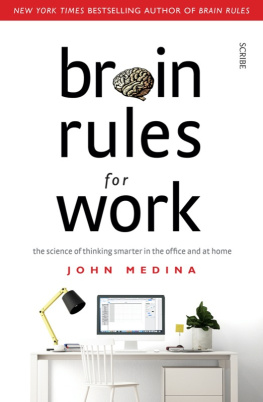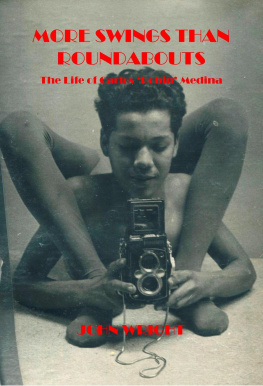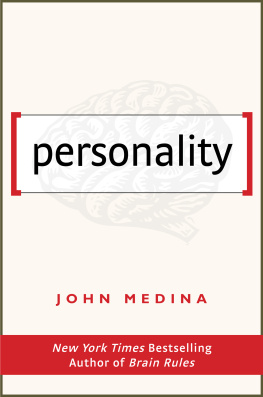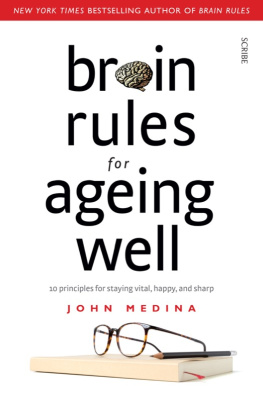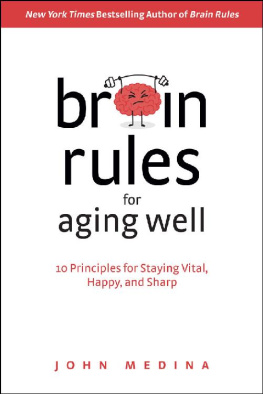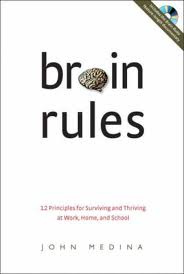Medina John - Brain Rules for Work
Here you can read online Medina John - Brain Rules for Work full text of the book (entire story) in english for free. Download pdf and epub, get meaning, cover and reviews about this ebook. year: 2021, publisher: Scribe Publications, genre: Romance novel. Description of the work, (preface) as well as reviews are available. Best literature library LitArk.com created for fans of good reading and offers a wide selection of genres:
Romance novel
Science fiction
Adventure
Detective
Science
History
Home and family
Prose
Art
Politics
Computer
Non-fiction
Religion
Business
Children
Humor
Choose a favorite category and find really read worthwhile books. Enjoy immersion in the world of imagination, feel the emotions of the characters or learn something new for yourself, make an fascinating discovery.
- Book:Brain Rules for Work
- Author:
- Publisher:Scribe Publications
- Genre:
- Year:2021
- Rating:3 / 5
- Favourites:Add to favourites
- Your mark:
- 60
- 1
- 2
- 3
- 4
- 5
Brain Rules for Work: summary, description and annotation
We offer to read an annotation, description, summary or preface (depends on what the author of the book "Brain Rules for Work" wrote himself). If you haven't found the necessary information about the book — write in the comments, we will try to find it.
Brain Rules for Work — read online for free the complete book (whole text) full work
Below is the text of the book, divided by pages. System saving the place of the last page read, allows you to conveniently read the book "Brain Rules for Work" online for free, without having to search again every time where you left off. Put a bookmark, and you can go to the page where you finished reading at any time.
Font size:
Interval:
Bookmark:

Brain Rules for Work
Dr John Medina, a developmental molecular biologist, has had a lifelong fascination with how the mind reacts to and organises information. He is the author of the internationally bestselling works Brain Rules , Brain Rules for Baby , and Brain Rules for Ageing Well . Medina is an affiliate professor of bioengineering at the University of Washington School of Medicine. He lives in Seattle, Washington.
Scribe Publications
1820 Edward St, Brunswick, Victoria 3056, Australia
2 John St, Clerkenwell, London, WC1N 2ES, United Kingdom
Published by Scribe 2021
Published by arrangement with Pear Press, Seattle, USA
Copyright 2021 by John J. Medina
All rights reserved. Without limiting the rights under copyright reserved above, no part of this publication may be reproduced, stored in or introduced into a retrieval system, or transmitted, in any form or by any means (electronic, mechanical, photocopying, recording or otherwise) without the prior written permission of the publishers of this book.
The moral rights of the author have been asserted.
Scribe acknowledges Australias First Nations peoples as the traditional owners and custodians of this country, and we pay our respects to their elders, past and present.
978 1 922585 24 0 (Australian edition)
978 1 914484 17 9 (UK edition)
978 1 922586 23 0 (e-book)
Catalogue records for this book are available from the National Library of Australia and the British Library.
scribepublications.com.au
scribepublications.co.uk
To my dear friend, Bruce Hosford,
one of the warmest, kindest souls I know.
contents
tailor your workplace with the brain in mind your brain is an energy hog teaming up gave us an advantage how COVID-19 will and wont change things
trust makes the team work dont interrupt book clubs hire more women why diversity is good for business
COVID-19 and the new workplace why Zoom is so tiring before your meeting, make a showrunners agenda what youre really avoiding when you procrastinate
biophilia wed rather be outside stress and the office forest bathing plants and natural light prospect-refuge
turning bricks into paint failing better yelling wont get you anywhere get in the flow the shifting game
the GIs general and Old Blood and Guts prestige and dominance even babies recognize leadership the rise and fall of Enron gratitude
the Lord of All Beasts a pair of controversial studies what power does to empathy a very bad band leader power and sex prophylactic education
the ten-minute rule how our emotions organize information attention-grabbing narratives attention-grabbing images on text and PowerPoint
restraining your emotions self-distancing writing it out bias, both explicit and implicit the Implicit Association Test prejudice habit-breaking intervention program
9 to 5 stress and control STAR program why businesses shouldnt fear employees with families why businesses should offer parental leave living messages
why the new is scarier than the now kids, marshmallows, and determination patience isnt enough friction dopamine and delight the limitations of willpower
10 brain rules for work
Teams are more productive, but only if you have the right people.
Your workday might look and feel a little different than before. Plan accordingly.
The brain developed in the great outdoors. The organ still thinks it lives there.
Failure should be an optionas long as you learn from it.
Leaders need a whole lot of empathy and a little willingness to be tough.
Power is like fire. It can cook your food or burn your house down.
Capture your audiences emotion, and you will have their attention (at least for ten minutes).
Conflicts can be resolved by changing your thought life. It helps to have a pencil.
You dont have a work brain and a home brain. You have a single brain functioning in two places.
Change wont happen out of determination and patience alone.
introduction
I ONCE STARTED A LECTURE to a group of business students by asking them this question: Why do we have five-fingered gloves ?
I waited to see if anyone would take a stab at the answer. When all I got were a few laughs and confused looks, I answered my own question: Humans make five-fingered gloves because humans have five-fingered hands! This prompted more laughter and, Im sure, a little more confusion. After all, they were there to listen to a neuroscientist talk about the business world, their business world in a few short years. What would gloves and fingers have to do with the workplace or their brains or both?
Well, duh , I intoned. Your brain has the cognitive equivalent of five fingers. The organ is shaped to respond with great productivity to certain environments and to other environments, with no productivity at all. I reasoned that ergonomics applies to the mind just as much as to the hand. If youre designing a workplace and want to optimize output, you better keep the cognitive shape of the brain in mind, I warned.
I went on to explain that the typical place of business is not designed with the cognitive equivalent of a five-fingered glove. And so I invited my temporary class to a thought experiment: What if the workplace were tailored to the brain, the way a glove is tailored to a hand? What would organizations look like if the business of profit-making took the business of brain function seriously? How would we design management structures? What would physical workspaces look like? What environment would best aid creativity, productivity, and the simple ability to just get thi ngs done?
The goal of this book is to answer questions just like these. Were going to explore how the application of the behavioral and cognitive neurosciences can improve your productivity in the workplace. The information is relevant whether youre working from the corner office at headquarters or from your closet office at home. Call it an exercise in cognitive er gonomics.
This wont be your typical book about work, however. Almost every concept here was braided by the deft hands of Charles Darwin. Were going to use his evolutionary ideas to outline the books central challenge: how to work with a brain that operates in the twenty-first century but still thinks it lives in the ancient Serengeti. Were going to explore how this jiggly three pounds of incredible problem-solving genius, finely tuned to spear mastodons and pick berries, learns instead to run staff meetings and read spre adsheets.
Sometimes the organ conforms only reluctantly. After all, our brains havent been exercising long enough in the civilization gym to completely break with the shackles of the Pleistocene, the prehistoric era in which the organ evolved inside the skulls of the first modern humans. Sometimes the brain conforms willingly to modern life, especially if we understand enough about its inner mechanisms to work with rather than against its natural tendencies. In a nutshell, were going to explore how the science side of behavior informs the business side of behaving.
This effort is divided into ten brain rules. These rules are things we know about the brain based on peer-reviewed science. You can apply each rule to the corresponding area of your work life. Some rules deal with specialized areas of business, such as hiring practices and presentations. Others deal with more general areas of interest, from workspace design to getting along with others. Well find out why youre so tired after Zoom meetings. Well examine what you can do to your office, whether at home or at your work building, to make you more productive (hint: add plants). Well learn why people become more interested in sex after theyve been promoted. Well explore the cognitive neuroscience behind creativity and teamwork, and discover the most effective ways to kill your PowerPoints. Well end with explaining why good, old-fashioned change is so hard for good, old-fashioned people. With this knowledge, we will discover how to work smarterdesigning our five-fingered glove, stitch b y stitch.
Next pageFont size:
Interval:
Bookmark:
Similar books «Brain Rules for Work»
Look at similar books to Brain Rules for Work. We have selected literature similar in name and meaning in the hope of providing readers with more options to find new, interesting, not yet read works.
Discussion, reviews of the book Brain Rules for Work and just readers' own opinions. Leave your comments, write what you think about the work, its meaning or the main characters. Specify what exactly you liked and what you didn't like, and why you think so.

